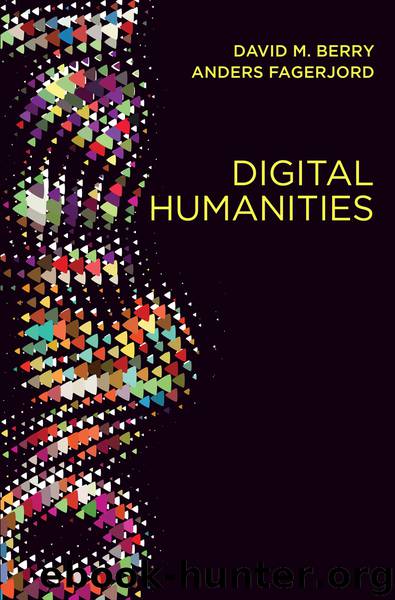Digital Humanities: Knowledge and Critique in a Digital Age by David M. Berry & Anders Fagerjord

Author:David M. Berry & Anders Fagerjord
Language: eng
Format: epub
ISBN: 9780745697697
Publisher: Polity
Published: 2017-06-15T00:00:00+00:00
Notes
1. That is to say that creating policies to aim for these ends is not the same as actually developing the usually difficult technical solutions to do this. Not only are the difficulty and complexity of digital projects something that digital humanities has broad experience of, but also it understands well the relationship between good research infrastructure provision and good technical solutions.
2. A good example of the specificity, if not idiosyncrasy, of classification is demonstrated by the unique classification system of the Warburg Institute Library in the School of Advanced Study at the University of London. It has a ‘unique classification system [in] the Library established by Aby Warburg and Fritz Saxl, and has been refined, extended and reorganised in particular sections by three generations of scholar librarians. It structures culture and expression under four categories: Image, Word, Orientation and Action, corresponding to the four floors of stacks above the Reading Room’. Indeed, it is claimed that ‘detailed organisation of the Warburg Library makes inspired connections between different fields of endeavour and study. The open shelves lead readers to books which they might not otherwise find, while the unique arrangement of the sections aids intuitive connections’ (Warburg 2016).
3. Kirschenbaum (2012a: 6) notes: ‘That the major federal granting agency for scholarship in the humanities, taking its cues directly from a small but active and influential group of scholars, had devoted scarce resources to launching a number of new grant opportunities, many of them programmatically innovative in and of themselves, around an endeavor termed “digital humanities” was doubtless the tipping point for the branding of DH, at least in the United States.’
4. On the subject of multimedia, see Rockwell and Mactavish (2004), who argue that various forms of born-digital content, made popular particularly with the rise of the internet, are amenable to digital humanities methods and approaches. See also Kolker (2004: 383).
5. The contradictory logics of building research capacity for the university to exercise research leadership in terms of each of its disciplinary specialisms and to encourage intellectual curiosity, whilst also being chained to the political economic needs of the nation, is something very common to these documents. Whilst we do not have space to develop this issue further, contradictions are also located in aspects of digital humanities’ own self-justifications that draw from these discourses.
6. See, for example, UK e-Science programme (Hey and Trefethen 2002).
7. A further ‘digging into data’ challenge was also announced in 2016 as part of the ODH-led Trans-atlantic Platform (see www.transatlanticplatform.com).
8. It also remains unsettling that research infrastructures might sometimes be seen as a means for engendering top-down change in both the higher education sector and individual universities. Whilst it is not always the case that digital infrastructure projects are mobilized in this way, nonetheless they sometimes lean towards a desire for bureaucratic control of certain research practices, but also indirectly of the research approaches that individual scholars might undertake. This is something that digital humanists should act to contest, and they should seek to ensure that research
Download
This site does not store any files on its server. We only index and link to content provided by other sites. Please contact the content providers to delete copyright contents if any and email us, we'll remove relevant links or contents immediately.
| Anthropology | Archaeology |
| Philosophy | Politics & Government |
| Social Sciences | Sociology |
| Women's Studies |
Born to Run: by Christopher McDougall(7023)
The Leavers by Lisa Ko(6872)
iGen by Jean M. Twenge(5320)
Sapiens by Yuval Noah Harari(5259)
The Kite Runner by Khaled Hosseini(5033)
Spare by Prince Harry The Duke of Sussex(4990)
Bullshit Jobs by David Graeber(3988)
Machine Learning at Scale with H2O by Gregory Keys | David Whiting(3941)
Never by Ken Follett(3697)
Goodbye Paradise(3658)
Livewired by David Eagleman(3618)
Fairy Tale by Stephen King(3150)
Harry Potter 4 - Harry Potter and The Goblet of Fire by J.K.Rowling(2936)
A Dictionary of Sociology by Unknown(2921)
The Social Psychology of Inequality by Unknown(2895)
The Club by A.L. Brooks(2808)
Will by Will Smith(2729)
0041152001443424520 .pdf by Unknown(2718)
People of the Earth: An Introduction to World Prehistory by Dr. Brian Fagan & Nadia Durrani(2672)
